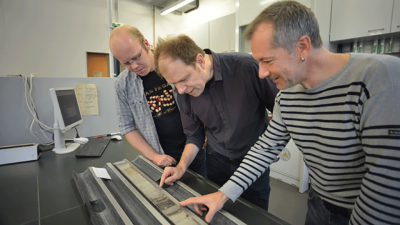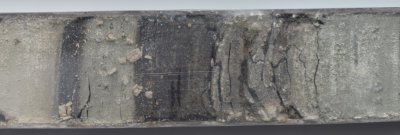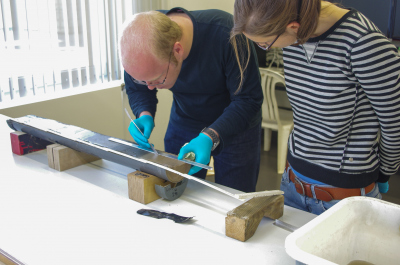Page path:
- Home
- Discover
- Media Releases
- Media Releases 2014
- Small steps, large impact
Small steps, large impact
In the past several millions of years, oxygen has been periodically absent from the deep Mediterranean Sea. As a result, sedimentary organic matter was not decomposed and accumulated on the sea floor. These episodes led to the formation of the so-called sapropels, which are dark, organic rich layers found in the sedimentary record. Dr. Lars Wörmer and his colleagues concentrated on the most recent of these sapropels, deposited about 6,000 to 9,000 years before present. In a six centimeter short sediment section they analyzed the distribution and abundance of lipid biomarkers on the cut surface of a sediment core by targeting smallest sampling spots with a laser. These lipids once formed the membranes of unicellular organisms, so-called planktonic archaea, populating the Mediterranean Sea. After the death of these organisms, their lipids remained preserved in the sediments. Using the novel approach, the team of geochemists was able to decode the spatial pattern of the molecules and extract information regarding the conditions in which they were produced.
"Until now we required large, centimeter sized samples to analyze these biomarkers, thus pooling decades or centuries of sedimentation into every sample" Dr. Lars Wörmer, a researcher at MARUM, says. With the newly developed method, resulting from a co-operation between MARUM and the Bremen based company Bruker Daltronik GmbH, the laser targets smallest sample spots every 0.25 millimeter across the sediment, directly retrieving information about past conditions at times represented by these small samples. The analyzed sample, which under “normal” high-resolution conditions would have yielded just about five measurements, was now characterized by more than 4000 measurements. According to Dr. Wörmer, first author of the PNAS publication, "our approach enables us to zoom into the environmental changes taking place during that time, which we can now probe with about four year resolution."
"Four years may sound like a lot" say Professor Kai-Uwe Hinrichs, head of the Organic Geochemistry group in MARUM, "but this resolution has already revealed unique insights". In their study, the authors for example describe a possible link between the changing environmental conditions in the Mediterranean Sea and solar cycles. "The rhythm in which the monitored parameters changed during that period of Earth's history is equivalent to the Suess or de Vries cycle" Hinrichs states. This cycle of solar variability, with a frequency of 212 years, may have defined temperature and precipitation patterns over the Mediterranean region, thereby shaping the conditions in which marine organisms thrived.
"In the future we want to expand this method to other informative biomarkers that contain additional, complementary clues to understand the ancient oceans" Prof. Hinrichs states. "Also, we are interested in settings with high sedimentation rates, in which we might even be able to reconstruct environmental changes on monthly time scales".
Publication:
Lars Wörmer, Marcus Elvert, Jens Fuchser, Julius Sebastian Lipp, Pier Luigi Buttigieg, Matthias Zabel, Kai-Uwe Hinrichs: Ultra-high-resolution paleoenvironmental records via direct laser-based analysis of lipid biomarkers in sediment core samples
In: Proceedings of the National Academy of Sciences, Early Online Edition, 20. Oktober 2014: http://www.pnas.org/content/early/2014/10/15/1405237111.abstract
More information / interviews / images:
Albert Gerdes
MARUM Public Relations
Phone: +49 - 421 218 65540
E-mail: [Bitte aktivieren Sie Javascript]
"Until now we required large, centimeter sized samples to analyze these biomarkers, thus pooling decades or centuries of sedimentation into every sample" Dr. Lars Wörmer, a researcher at MARUM, says. With the newly developed method, resulting from a co-operation between MARUM and the Bremen based company Bruker Daltronik GmbH, the laser targets smallest sample spots every 0.25 millimeter across the sediment, directly retrieving information about past conditions at times represented by these small samples. The analyzed sample, which under “normal” high-resolution conditions would have yielded just about five measurements, was now characterized by more than 4000 measurements. According to Dr. Wörmer, first author of the PNAS publication, "our approach enables us to zoom into the environmental changes taking place during that time, which we can now probe with about four year resolution."
"Four years may sound like a lot" say Professor Kai-Uwe Hinrichs, head of the Organic Geochemistry group in MARUM, "but this resolution has already revealed unique insights". In their study, the authors for example describe a possible link between the changing environmental conditions in the Mediterranean Sea and solar cycles. "The rhythm in which the monitored parameters changed during that period of Earth's history is equivalent to the Suess or de Vries cycle" Hinrichs states. This cycle of solar variability, with a frequency of 212 years, may have defined temperature and precipitation patterns over the Mediterranean region, thereby shaping the conditions in which marine organisms thrived.
"In the future we want to expand this method to other informative biomarkers that contain additional, complementary clues to understand the ancient oceans" Prof. Hinrichs states. "Also, we are interested in settings with high sedimentation rates, in which we might even be able to reconstruct environmental changes on monthly time scales".
Publication:
Lars Wörmer, Marcus Elvert, Jens Fuchser, Julius Sebastian Lipp, Pier Luigi Buttigieg, Matthias Zabel, Kai-Uwe Hinrichs: Ultra-high-resolution paleoenvironmental records via direct laser-based analysis of lipid biomarkers in sediment core samples
In: Proceedings of the National Academy of Sciences, Early Online Edition, 20. Oktober 2014: http://www.pnas.org/content/early/2014/10/15/1405237111.abstract
More information / interviews / images:
Albert Gerdes
MARUM Public Relations
Phone: +49 - 421 218 65540
E-mail: [Bitte aktivieren Sie Javascript]
Dark sapropel layers in a core, that was drilled in the Mediterranean Sea in early 1995 to the southeast of Sicily. The expedition took place in the framework of the Integrated Ocean Drillling Program IODP. The core is being stored in the IODP Core Repository in the MARUM building.
Dr. Lars Wörmer, first author of the PNAS paper, samples a sapropel core from the Mediterranean Sea. Master student Susanne Alfken is assisting.





